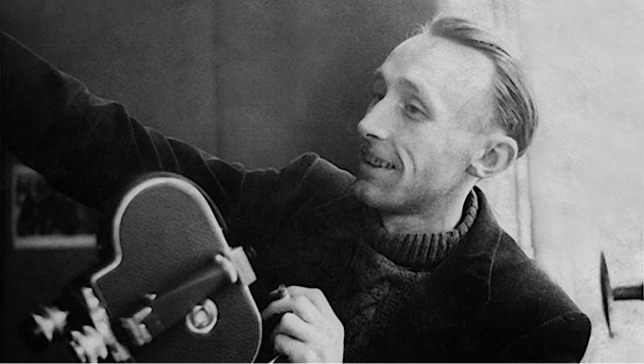
当前课程知识点:英语电影与文化 > Unit 12 The English Patient: Critical Analysis > Unit 12 The English Patient: Critical Analysis > Unit 1 Film Form I
The Evolution of the Language of Cinema (excerpt)

Through the contents of the image and the resources of. montage, the cinema has at its disposal a whole arsenal of means whereby to impose its interpretation of an event on the spectator. By the end of the silent film we can consider this arsenal to have been full. On the one side the Soviet cinema carried to its ultimate consequences the theory and practice of montage while the German school did every kind of violence to the plastics of the image by way of sets and lighting. Other cinemas count too besides the Russian and German, but whether in France or Sweden or the United States, it does not appear that the language of cinema was at a loss for ways of saying what it wanted to say.
If the art of cinema consists in everything that plastics and montage can add to a given reality, the silent film was an art on its own. Sound could only play at best a subordinate and supplementary role: a counterpoint to the visual image. But this possible enhancement-at best only a minor one-is likely not to weigh much in comparison with the additional bargain-rate reality introduced at the same time by sound.
Thus far we have put forward the view that expressionism of montage and image constitute the essence of cinema. And it is precisely on this generally accepted notion that directors from silent days, such as Erich von Stroheim, F. W. Murnau, and Robert Flaherty, have by implication cast a doubt. In their films, montage plays no part, unless it be the negative one of inevitable elimination where reality superabounds. The camera cannot see everything at once but it makes sure not to lose any part of what it chooses to see.
What matters to Flaherty, confronted with Nanook hunting the seal, is the relation between Nanook and the animal; the actual length of the waiting period. Montage could suggest the time involved. Flaherty however confines himself to showing the actual waiting period; the length of the hunt is the very substance of the image, its true object. Thus in the film this episode requires one setup. Will anyone deny that it is thereby much more moving than a montage by attraction?
Murnau is interested not so much in time as in the reality of dramatic space. Montage plays no more of a decisive part in Nos/eratu than in Sunrise. One might be inclined to think that the plastics of his image are expressionistic. But this would be a superficial view. The composition of his image is in no sense pictorial. It adds nothing to the reality, it does not deform it, it forces it to reveal its structural depth, to bring out the preexisting relations which become constitutive of the drama. For example, in Tabu, the arrival of a ship from left screen gives an immediate sense of destiny at work so that Murnau has no need to cheat in any way on the uncompromising realism of a film whose settings are completely natural.
But it is most of all Stroheim who rejects photographic expressionism and the tricks of montage. In his films reality lays itself bare like a suspect confessing under the relentless examination of the commissioner of police. He has one simple rule for direction. Take a close look at the world, keep on doing so, and in the end it will lay bare for you all its cruelty and its ugliness. One could easily imagine as a matter of fact a film by Stroheim composed of a single shot as long-lasting and as close-up as you like. These three directors do not exhaust the possibilities. We would undoubtedly find scattered among the works of others elements of nonexpressionistic cinema in which montage plays no including Griffith.
But these examples suffice to reveal, at the very heart of the silent film, a cinematographic art the very opposite of that which has been identified as "cinema par excellence," a language the semantic and syntactical unit of which is in no sense the Shot; in which the image is evaluated not according to what it adds to reality but what it reveals of it. In the latter art the silence of the screen was a drawback, that is to say, it deprived reality of one of its elements. Greed, like Dreyer's Jeanne d'Arc, is already virtually a talking film. The moment that you cease to maintain that montage and the plastic composition of the image are the very essence of the language of cinema, sound is no longer the aesthetic crevasse dividing two radically different aspects of the seventh art. The cinema that is believed to have died of the soundtrack is in no sense "the cinema." The real dividing line is elsewhere. It was operative in the past and continues to be through thirty-five years of the history of the language of the film.
From André Bazin What Is Cinema? (1967)
-1.1 Overview
--Video
-1.2 Mise-en-scène: setting
--Video
-1.3 Mise-en-scène: lighting
--Video
-1.4 Mise-en-scène: character appearance
--Video
-1.5 Mise-en-scène: performance
--Video
-1.6 Screen space and composition
--Video
-1.7 Case study
--Video
-Unit1 Questions for discussion
-Unit 1 单元测试
-2.1 Introduction of cinematography
--Video
-2.2 Cinematography: angle of framing
--Video
-2.3 Cinematography: camera distance
--Video
-2.4 Cinematography: mobile framing
--Video
-2.5 Case study
--Video
-Unit 2 Questions for discussion
-Unit 2 单元测试
-3.1 Overview
--Video
-3.2 Openings, closings, and story development
--Video
-3.3 Range of story information: restricted or unrestricted
--Video
-Unit 3 Questions for discussion
-Unit 3 单元测试
-4.1 Overview
--Video
-4.2 Editing and speed of narrative
--Video
-4.3 Chronology and continuity editing
--Video
-4.4 Flashbacks and editing
--Video
-Unit 4 Questions for Discussion
-Unit 4 单元测试
-5.1 Overview
--Video
-5.2 What is semiotics?
--Video
-5.3 Christian Metz
--Video
-5.4 Roland Barthes (Part 1)
--Video
-5.5 Roland Barthes (Part 2)
--Video
-5.6 Case study: 2001: A Space Odyssey
--Video
-Unit 5 Questions for Discussion
-Unit 5 单元测试
-6.1 Overview
--Video
-6.2 Origins of film ideology
--Video
-6.3 Media and technology
--Video
-6.4 Cultural hegemony and counterhegemony
--Video
-6.5 Case study: Star Trek
--Video
-Unit 6 Questions for discussion
-Unit 6 单元测试
-7.1 Overview
--Video
-7.2 Woman and film
--Video
-7.3 Feminist film theory and practice
--Video
-7.4 Case study: Three Billboards Outside Ebbing, Missouri
--Video
-7.5 Masculinity
--Video
-7.6 Queer Cinema
--Video
-Unit 7 Questions for discussion
-Unit 7 单元测试
-8.1 Overview
--Video
-8.2 Race and racism
--Video
-8.3 Stereotypes of racial representation
--Video
-8.4 Whiteness
--Video
-8.5 Case study: Rabbit-Proof Fence
--Video
-Unit 8 Questions for discussion
-Unit 8 单元测试
-9.1 Overview
--Video
-9.2 Edward Said and Orientalism
--Video
-9.3 Cultural Imperialism
--Video
-9.4 Self-orientation
--Video
-9.5 Case study I: Mulan
--Video
-9.6 Case study II: M Butterfly
--Video
-Unit 9 Questions for discussion
-Unit 9 单元测试
-10.1 Overview
--Video
-10.2 Early Background
--Video
-10.3 Jacques Lacan
--Video
-10.4 Laura Mulvey
--Video
-10.5 Case Study: Shutter Island
--Video
-Unit 10 Questions for discussion
-Unit 10 单元测试
-Unit 10 Film and Psychoanalysis
-11.1 Overview
--Video
-11.2 Story
--Video
-11.3 Character: the enigmatic English patient
--Video
-11.4 Mise-en-scène: setting
--Video
-11.5 Narrative
--Video
-11.6 Music
--Video
-Unit 11 Questions for discussion
-Unit 11 单元测试
-Unit 11 The English Patient: Form and Narrative
-12.1 Signs and Symbols
--Video
-12.2 Nationalism in The English Patient
--Video
-12.3 Almasy as the misogynist and Katharine as a feminist
--Video
-12.4 Kip as the Other
--Video
-Unit 12 Questions for discussion
-Unit 12 单元测试


